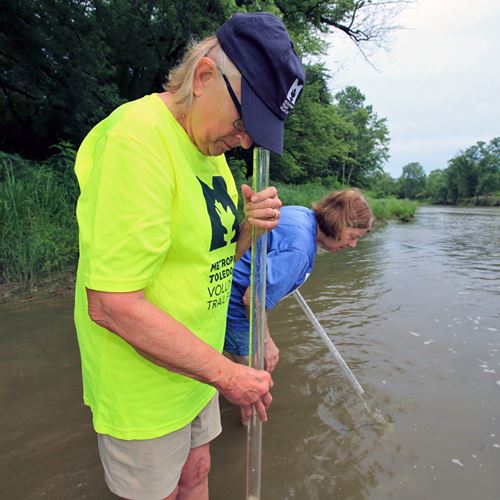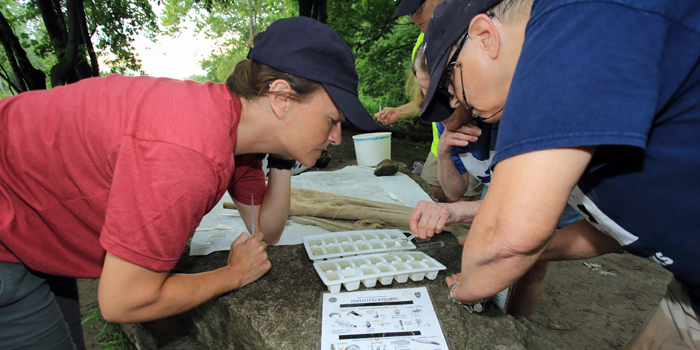Lake Erie Communities Standardize Data Collection for Watershed Health

Metroparks works with partners to accelerate safe and accessible water
The Lake Erie Volunteer Science Network (LEVSN) –- a collaboration of 16 water-quality monitoring programs convened by Cleveland Water Alliance -- has published a set of standards for volunteer-collected data.
The purpose of the new Lake Erie Baseline Assessment Framework is to give communities new tools to tell a regional story about the health of our watersheds and support environmental education, research and management.
“It is our goal to connect parks to people and people to parks,” said Jennifer Elsworth, a program manager at Metroparks. “The more we can get people to interact with and become familiar with our waterfront ecosystems, the more likely they are going to want to be involved in keeping these environments healthy.”
Citizen science volunteers, like those at Metroparks, have monitored water quality across their watersheds for years. However, challenges around the credibility and consistency of the collected data have often meant that experts and communities struggle to fill critical information gaps and support the management of our most precious natural resources.
To address these challenges, researchers and decision makers at CWA’s 2022 Lake Erie Citizen Science Summit developed the new standards to help local groups address water governance, research, and advocacy challenges facing Lake Erie communities.
“The Lake Erie Volunteer Science Network has accelerated the existing organizational and grassroots volunteer monitoring ecosystem with the latest technology and a standardized framework for collecting and communicating credible environmental information,” said Dr. Christopher Winslow, Director of the Ohio Sea Grant College Program.
The standards, which will be implemented in northwest Ohio next year, provide a framework for new and existing volunteer programs to elevate the credibility of their work and chart a path for expanding and improving over time. At the end of each field season, LEVSN will analyze and communicate data-based findings to participants and the public, driving progress towards the goal of clean and accessible water for all Lake Erie communities.
In partnership with The Commons, the collaborative has also supported the development of an Open API that will increase the visibility of volunteer-collected data through state and federal databases, enabling easy connection to decision making, analysis and modeling tools.

Over the past two years, LEVSN has piloted innovative technologies communities can use to monitor nutrient pollution and harmful algal bloom toxins. This technology is currently in use at Glass City, Middlegrounds, Wildwood Preserve, Side Cut, Farnsworth and Providence Metroparks. LimnoTech’s Affordable Sensor Kit is in its first year of use at Providence. The device will provide accessible data for milling operations at the historic Isaac Ludwig Mill as well as new education opportunities for local schools.
“Metroparks volunteer water quality monitoring program is very accessible in the respect that no science background is required. Anyone can learn the skills necessary to accurately record and gather this data that will impact water quality in northwest Ohio and beyond,” Ms. Elsworth said.
Toledo Metropolitan Area Council of Governments (TMACOG) will implement LEBAF through its Student Watershed Watch program. In operation since 1989, the program provides water quality sampling equipment and guidance to northwest Ohio and southeast Michigan teachers and students in grades 5-12.
Partners for Clean Streams, a local non-profit, is coordinating efforts to collaborate and expand volunteer monitoring, in collaboration with Metroparks and TMACOG, and to implement the LEBAF framework and resources locally. The Greater Toledo Community Foundation supported this coordination effort locally.
--
Since its inception, the Cleveland Water Alliance has managed LEVSN on behalf of the GLOW Lake Erie Partnership which includes Ralph C. Wilson, Jr. Foundation, Council of Michigan Foundations (CMF), Great Lakes Protection Fund, Greater Toledo Community Foundation, Lorain County Community Foundation, Cleveland Foundation, Northern Chautauqua Community Foundation, and Community Foundation for Greater Buffalo.